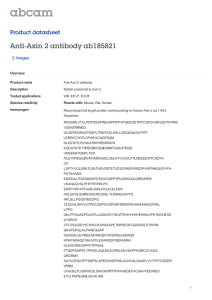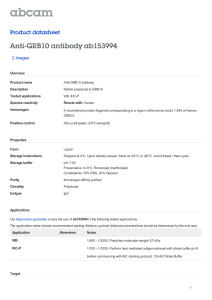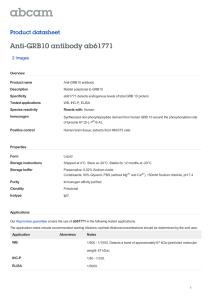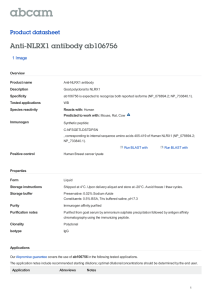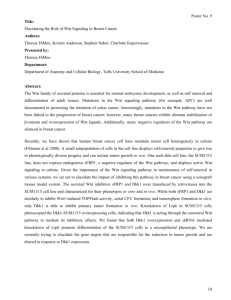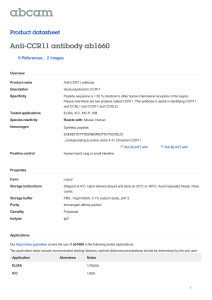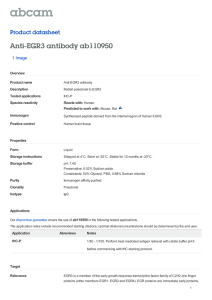Anti-LRP6 antibody ab24386 Product datasheet 2 References 2 Images
advertisement
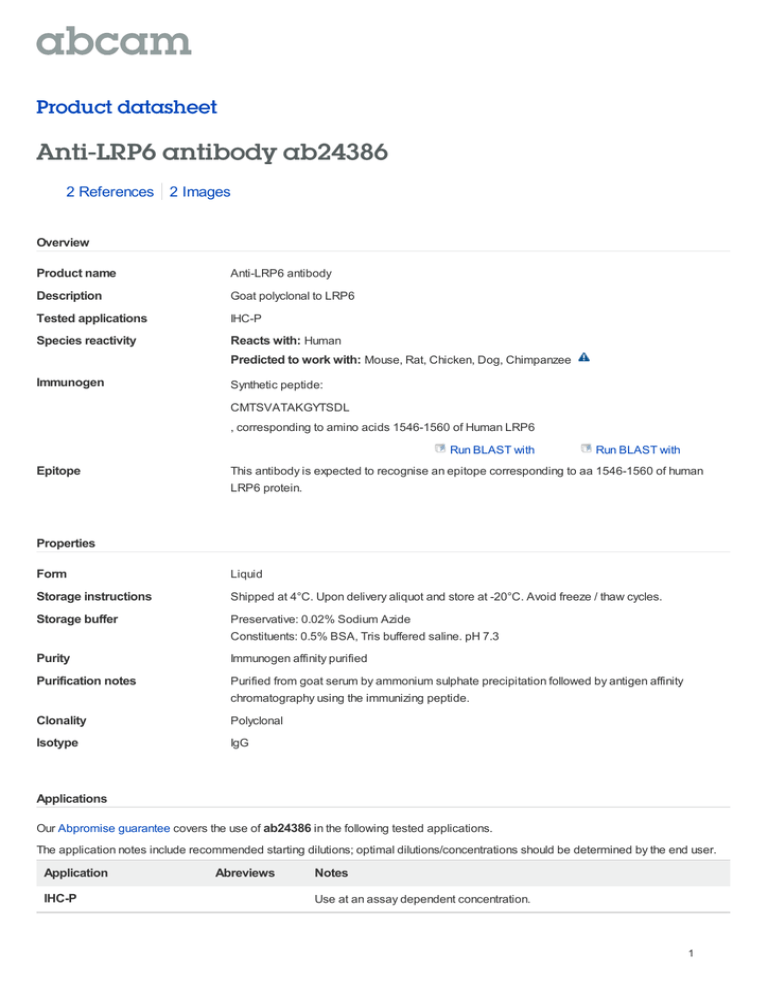
Product datasheet Anti-LRP6 antibody ab24386 2 References 2 Images Overview Product name Anti-LRP6 antibody Description Goat polyclonal to LRP6 Tested applications IHC-P Species reactivity Reacts with: Human Predicted to work with: Mouse, Rat, Chicken, Dog, Chimpanzee Immunogen Synthetic peptide: CMTSVATAKGYTSDL , corresponding to amino acids 1546-1560 of Human LRP6 Run BLAST with Epitope Run BLAST with This antibody is expected to recognise an epitope corresponding to aa 1546-1560 of human LRP6 protein. Properties Form Liquid Storage instructions Shipped at 4°C. Upon delivery aliquot and store at -20°C. Avoid freeze / thaw cycles. Storage buffer Preservative: 0.02% Sodium Azide Constituents: 0.5% BSA, Tris buffered saline. pH 7.3 Purity Immunogen affinity purified Purification notes Purified from goat serum by ammonium sulphate precipitation followed by antigen affinity chromatography using the immunizing peptide. Clonality Polyclonal Isotype IgG Applications Our Abpromise guarantee covers the use of ab24386 in the following tested applications. The application notes include recommended starting dilutions; optimal dilutions/concentrations should be determined by the end user. Application IHC-P Abreviews Notes Use at an assay dependent concentration. 1 Target Function Component of the Wnt-Fzd-LRP5-LRP6 complex that triggers beta-catenin signaling through inducing aggregation of receptor-ligand complexes into ribosome-sized signalsomes. Cellsurface coreceptor of Wnt/beta-catenin signaling, which plays a pivotal role in bone formation. The Wnt-induced Fzd/LRP6 coreceptor complex recruits DVL1 polymers to the plasma membrane which, in turn, recruits the AXIN1/GSK3B-complex to the cell surface promoting the formation of signalsomes and inhibiting AXIN1/GSK3-mediated phosphorylation and destruction of beta-catenin. Required for posterior patterning of the epiblast during gastrulation. Tissue specificity Widely co-expressed with LRP5 during embryogenesis and in adult tissues. Involvement in disease Defects in LRP6 are the cause of autosomal dominant coronary artery disease type 2 (ADCAD2) [MIM:610947]. Sequence similarities Belongs to the LDLR family. Contains 4 EGF-like domains. Contains 3 LDL-receptor class A domains. Contains 20 LDL-receptor class B repeats. Domain The YWTD-EGF-like domains 1 and 2 are required for the interaction with Wnt-frizzled complex. The YWTD-EGF-like domains 3 and 4 are required for the interaction with DKK1. The PPPSP motifs play a central role in signal transduction by being phosphorylated, leading to activate the Wnt signaling pathway. Post-translational modifications Dual phosphorylation of cytoplasmic PPPSP motifs sequentially by GSK3 and CK1 is required for AXIN1-binding, and subsequent stabilization and activation of beta-catenin via preventing GSK3-mediated phosphorylation of beta-catenin. Phosphorylated, in vitro, by GRK5/6 within and outside the PPPSP motifs. Phosphorylation at Ser-1490 by CDK14 during G2/M phase leads to regulation of the Wnt signaling pathway during the cell cycle. Phosphorylation by GSK3B is induced by RPSO1 binding and inhibited by DKK1. Phosphorylated, in vitro, by casein kinase I on Thr-1479. Undergoes gamma-secretase-dependent regulated intramembrane proteolysis (RIP). The extracellular domain is first released by shedding, and then, through the action of gammasecretase, the intracellular domain (ICD) is released into the cytoplasm where it is free to bind to GSK3B and to activate canonical Wnt signaling. Palmitoylation on the two sites near the transmembrane domain leads to release of LRP6 from the endoplasmic reticulum. Mono-ubiquitinated which retains LRP6 in the endoplasmic reticulum. N-glycosylation is required for cell surface location. Cellular localization Membrane. Endoplasmic reticulum. On Wnt signaling, undergoes a cycle of caveolin- or clathrinmediated endocytosis and plasma membrane location. Released from the endoplasmic reticulum on palmitoylation. Mono-ubiquitination retains it in the endoplasmic reticulum in the absence of palmitoylation. On Wnt signaling, phosphorylated, aggregates and colocalizes with AXIN1 and GSK3B at the plasma membrane in LRP6-signalsomes. Chaperoned to the plasma membrane by MESD. Anti-LRP6 antibody images 2 Ab24386 (5ug/ml) staining human LRP6 in human liver tissue by immunohistochemistry using paraffin embedded tissue. Steamed antigen retrieval with citrate buffer pH 6, AP-staining. In paraffin embedded Human Liver shows strong cytoplasmic staining in hepatocytes Immunohistochemistry (Paraffin-embedded and cytoplasmic staining in bile ductulus cells. sections) - LRP6 antibody (ab24386) ab24386 staining LRP6 in Human Kidney at 4µg/ml by Immunohistochemistry (Formalin/PFA-fixed paraffin-embedded sections). Sections were subjected to steamed antigen retrieval with citrate buffer pH 9.0, and antibody was visualised with Immunohistochemistry (Formalin/PFA-fixed HRP-staining. paraffin-embedded sections) - LRP6 antibody (ab24386) Please note: All products are "FOR RESEARCH USE ONLY AND ARE NOT INTENDED FOR DIAGNOSTIC OR THERAPEUTIC USE" Our Abpromise to you: Quality guaranteed and expert technical support Replacement or refund for products not performing as stated on the datasheet Valid for 12 months from date of delivery Response to your inquiry within 24 hours We provide support in Chinese, English, French, German, Japanese and Spanish Extensive multi-media technical resources to help you We investigate all quality concerns to ensure our products perform to the highest standards If the product does not perform as described on this datasheet, we will offer a refund or replacement. For full details of the Abpromise, please visit http://www.abcam.com/abpromise or contact our technical team. Terms and conditions Guarantee only valid for products bought direct from Abcam or one of our authorized distributors 3
![Anti-LRP6 (phospho S1490) antibody [EP2360Y] ab76417](http://s2.studylib.net/store/data/012726592_1-3457053e44c65010caf36ccb43a18653-300x300.png)
![Anti-LRP6 antibody [EPR2423(2)] ab134146 Product datasheet 1 Abreviews 3 Images](http://s2.studylib.net/store/data/012726591_1-7fdc130077d290aefa62368660600c5b-300x300.png)
